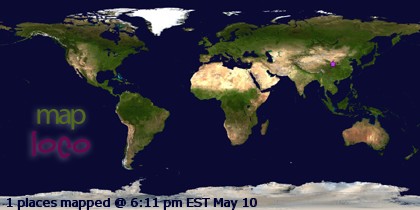It's hard to believe that I've now been living in Spain almost nine months. If we lived in a world where countries and people could create life, I would be giving birth any moment now. And every day has brought a surprise, a new vocabulary word, and interesting culture observation. While some of them have been (and will be) worth their own blog entries, others are worth a passing mention. I've compiled a few noteworthy tidbits here; you can expect more in other entries of this type in the future.
1) Punk rock grandmas
In the United States, dying one's hair is certainly not an uncommon practice, but most people limit their chosen hue to shades naturally found on heads around the world (if not their own particular strands.) Those individuals choosing more dramatic blues, greens, or pinks are generally understood to be making a Statement. Sure, those statements may vary, but the general message is the same: defiance and exclamation. Look at me-- see that I am different than you are.
It was thus with some confusion that I noticed women, mostly older women, walking around Palencia with magenta hair. Some of them had dyed their entire heads; others merely had a few vivid streaks--but it all seemed to be the same shade, almost as if they were sharing the bottle. This was something different than the "blue tint" effect occasionally seen in the US among senior citizens. It was clearly a purposeful, bold (in both senses of the word) choice.
Later on, I'd travel to northern Spain, to Basque country, and see many older women with similarly dyed hair, although this time with aqua/turquoise/blue hues. Nobody gives them a second look, neither in Palencia nor up north. Here it seems to be just another way to deal with graying hair and the aging process in general-- and I've decided I like it a lot.
2) Hellogoodbye
Like English (or, I imagine, most languages), Spanish has a cornucopia of various expressions for use in greetings. They differ based on the intimacy or mood of the speakers, the time of day, and the country (or in this case part of Spain) where they're greeting each other. This in itself is not remarkable.
However, after a month in Palencia, once I had moved into my own apartment, I started to notice something odd. Whenever my roommate came in to the apartment she said, "Hola." Without fail, when she left she called out, "Hasta luego!" even if we hadn't spoken in between. [A note on "Hasta luego" (which means "see you later) in Castilla y Leon: This phrase is constantly used, but the syllables rarely all appear together. The Palentino 'Hasta luego' is slurred together so quickly that you almost don't hear the first word at all. Try as I might, I haven't been able to successfully recreate it.]
But I digress. After I noticed my roommate's behavior, I started to see parallels in the behavior of others in my apartment building. Often when we crossed paths at the mailbox or in the doorway they would greet me with a friendly "Buenos dias" or "Muy buenas." They always followed this up with the famous Palentino "Ha-luego." Even in the elevator, I would be greeted, thirty seconds of elevator silence would ensue--and then, there it was again, the departing greeting. In the end, I remain puzzled but have concluded that greetings are a more important part of etiquette here than in the US, even among strangers.
3) Out for a walk
I've mentioned the "paseo" in this blog before, but it's worth revisiting. Palencia's Calle Mayor is a scenic pedestrianized mile lined with stores and 19th century buildings. In the winter the wind can be wicked, but the summer finds tin tables and umbrellas set out to enjoy the atmosphere. The street is a strange animal, a chameleon of sorts-- on Sunday afternoons and evenings after 11:30 pm it's virtually a movie set, complete empty and eerily clean (the sanitation department here is admirably diligent.) But there is a period of time every day before dinner (between the hours of 6 and 8, I would say) when Palentinos (and, I think, many northern Spaniards) like to go out for a stroll.
During that time Calle Mayor is teeming, sometimes even choked, with pedestrians. Some walk faster, some saunter. Many older couples hobble arm in arm, some adult children push their parents in wheelchairs, and there are always young kids weaving in and out of the chaos chasing a soccer ball. Everywhere there are clumps of people stopping to chat, young mothers showing off new babies, teenagers flirting and joking, people window shopping and chatting about the day's news. Sometimes there are balloon sellers; in the winter a series of wooden shacks appeared selling hot fresh mini-donuts and roasted chestnuts. It's Palentino life in a two-hour nutshell, and although I dread the thought of biking anywhere during that time (an experience like nothing more than a first-person video game), the feeling of walking the street during paseo--idly watching people, catching snatches of conversation, and feeling the energy of so many people ricocheting off the high pastel buildings--remains one of my favorites from my time here.


























